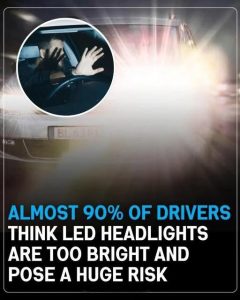Over the past years, automotive technology has been moving fast and one of the major changes would be the widespread use of LED headlights in most modern vehicles. rechargeable battery operated • high energy efficiency • sleek appearance • longevity of these lights have made them the new standard in automotive lights But while their technical advantages are undeniable, LED headlights have been bringing growing concerns on the roads among drivers who have found the lights so bright they are almost hazardous for oncoming traffic.
A recent survey confirms this fact, as almost 90% of drivers feel LED headlights are too bright. A growing number of folks report being slightly blinded or disoriented; the question becomes, are LED headlights making the roads safer just for the driver while making it a lot less so for everyone else? How do we manage technological progress versus public safety?

In fact, the vast majority of new cars no longer have traditional halogen bulbs as the standard, nowadays they have LEDs (Light EmittingDiodes). Mostly this rise comes because of few good benefits. Whereas halogen bulbs waste a large amount of their energy as heat, LEDs convert most of their energy into light. LEDs are more sustainable and eco friendly due to their efficiency. In addition, they are ten of thousands of hours long, far longer than halogens, requiring less frequent replacements for car owners. LEDs produce a beam with a better focus and, in low light conditions, they are more illuminant. In addition, they further help with the modern, futuristic style of most vehicles.
With these advantages, LED headlights have become highly attractive to the manufacture and consumers alike. Indeed, as with so many inventions, however, there are benefits in one sphere which can come with new problems in another.
Drivers like how enhanced visibility LEDs provide, but a growing number of people are starting to grow rather frustrated—maybe even afraid—with how these headlights affect other drivers on the road. LED headlights are known to be very bright and very white, which produce glare, particularly for other drivers or for drivers using rearview mirrors. Overly bright headlights can cause temporary visual impairment, discomfort, or more in some people trigger migraines and night driving anxiety. The impact is even more serious for older drivers or drivers with vision sensitivities. Additionally, because LED beams are more focused and directed than the halogen, their placing is so critical. LED headlights are poorly aligned or have not been installed correctly, and thus can produce flashing blinds impossible to dodge.
The automotive industry, regulators, and the driving communities have talked at length about the growing discontent with LED headlight brightness. There are safety steps to take even as LED technology is here to stay. Additional rules on headlight intensity, color temperature, beam pattern could be stipulated more specifically by governments and transportation authorities to ensure road safety for all road users. In adaptive lighting, manufacturers can improve high beam dimming for safety or brightness regardless of traffic. If replacing your headlights with aftermarket LED kits, car owners need to be educated on proper headlight alignment. Thus, middle ground solutions based on diffused LED lighting or anti glare designs could also lead to innovations in the realm of diffused LED lighting or anti glare designs.
Since automotive tech is always evolving, any improvements must be made to shared road safety. There are many irrefutable benefits to LED headlights but the conversation now has to move on to how to implement responsible LED headlights. Through regulating, designing, and educating consumers with regard to issues of glare and brightness, we can continue to benefit from the positive side of new lighting without compromising other people’s ability to see and be seen on the road.
For now: until those wheels are streamlined fully usable in mashups for that brighter future, use and respect of roads will be mutual.
